Evaluation of the Sensitivity of PBL and SGS Treatments in Different Flow Fields Using the WRF-LES at Perdigão
Abstract
1. Introduction
2. Materials and Methods
2.1. Perdigão
2.2. Case Selection
2.3. Multiscale Simulation Setup
3. Results and Discussion
3.1. Description of Sensitivity Experiments
3.2. Northeastern Flow
3.3. Southwestern Flow
4. Conclusions
Author Contributions
Funding
Data Availability Statement
Acknowledgments
Conflicts of Interest
Abbreviations
| a.g.l. | Above ground level |
| CFD | Computational fluid dynamics |
| CLC | Corine Land Cover |
| CORINE | Coordination of Information on the Environment |
| ECMWF | European Centre for Medium-range Weather Forecast |
| ERA5 | ECMWF reanalysis 5th generation |
| GTOPO30 | Global topography at 30 arcsec |
| IBC | Initial boundary condition |
| IOP | Intensive operational period |
| LESLLJ | Large eddy simulationLow-level jet |
| MYNN | Mellor–Yamada–Nakanishi–Niino level 2.5 |
| MWR | Microwave radiometer |
| NBA | Nonlinear backscatter and anisotropy |
| NCAR | National Center for Atmospheric Research |
| NE | Northeast |
| NEWA | New European Wind Atlas |
| PBL | Planetary boundary layer |
| RASS | Radio acoustic sounding system |
| SFS | Subfilter scale |
| SGS | Subgrid scale |
| SH | Shin–Hong |
| SMAG | Smagorinsky |
| SRTM | Shuttle Radar Topography Mission |
| SW | Southwest |
| TKE | 1.5-order turbulence kinetic energy closure |
| UCAR | University Corporation for Atmospheric Research |
| USGS | United States Geological Survey |
| YSU | Yonsei University |
| WAsP | Wind Atlas Analysis and Application Program |
| WRF | Weather Research and Forecasting model |
| WRF-LES | Weather Research and Forecasting model and large eddy simulation |
Appendix A
| PBL | SGS | z [m a.g.l.] | Mast 20 | Mast 25 | Mast 29 | |||
|---|---|---|---|---|---|---|---|---|
| NE | SW | NE | SW | NE | SW | |||
| MYNN | TKE | 100 | 3.69 | 2.01 | 4.42 | 3.14 | 1.51 | 1.86 |
| 60 | 3.45 | 1.95 | 3.78 | 2.87 | 2.56 | 1.85 | ||
| 30 | 3.22 | 1.86 | 2.56 | 2.49 | 3.05 | 1.84 | ||
| 10 | 3.13 | 1.77 | 1.63 | 2.07 | 3.85 | 1.82 | ||
| SMAG | 100 | 3.51 | 2.00 | 4.27 | 3.54 | 1.43 | 2.20 | |
| 60 | 3.35 | 1.89 | 3.08 | 3.25 | 2.07 | 2.17 | ||
| 30 | 3.02 | 1.82 | 2.43 | 2.98 | 2.92 | 2.13 | ||
| 10 | 2.88 | 1.68 | 1.80 | 2.73 | 3.99 | 2.11 | ||
| NBA | 100 | 3.48 | 1.94 | 4.83 | 3.07 | 1.35 | 2.21 | |
| 60 | 3.34 | 1.89 | 3.98 | 2.92 | 1.89 | 2.08 | ||
| 30 | 3.13 | 1.82 | 3.05 | 2.78 | 2.67 | 1.99 | ||
| 10 | 2.97 | 1.70 | 2.03 | 2.63 | 3.79 | 1.90 | ||
| SH | TKE | 100 | 3.61 | 2.07 | 4.36 | 3.54 | 1.79 | 1.96 |
| 60 | 3.35 | 2.06 | 3.69 | 3.17 | 2.16 | 1.90 | ||
| 30 | 3.01 | 2.05 | 2.31 | 2.95 | 2.95 | 1.82 | ||
| 10 | 2.72 | 2.05 | 1.34 | 2.27 | 3.72 | 1.76 | ||
| SMAG | 100 | 3.39 | 1.97 | 3.94 | 3.63 | 1.37 | 2.06 | |
| 60 | 3.04 | 1.89 | 2.73 | 3.30 | 2.01 | 2.03 | ||
| 30 | 2.91 | 1.85 | 2.00 | 3.00 | 3.02 | 2.00 | ||
| 10 | 2.48 | 1.80 | 1.42 | 2.74 | 3.79 | 1.98 | ||
| NBA | 100 | 3.37 | 1.90 | 4.64 | 3.27 | 1.46 | 2.10 | |
| 60 | 3.08 | 1.88 | 3.65 | 3.04 | 1.90 | 2.01 | ||
| 30 | 2.96 | 1.84 | 2.13 | 2.92 | 2.45 | 1.95 | ||
| 10 | 2.58 | 1.82 | 1.71 | 2.72 | 3.66 | 1.84 | ||
| YSU | TKE | 100 | 4.00 | 2.06 | 4.23 | 3.80 | 2.36 | 2.18 |
| 60 | 3.48 | 1.94 | 3.58 | 3.48 | 2.95 | 2.09 | ||
| 30 | 3.01 | 1.82 | 2.82 | 2.97 | 3.27 | 1.99 | ||
| 10 | 2.92 | 1.73 | 1.37 | 2.60 | 3.82 | 1.86 | ||
| SMAG | 100 | 3.96 | 1.96 | 4.14 | 3.78 | 2.27 | 2.06 | |
| 60 | 3.65 | 1.90 | 3.56 | 3.35 | 2.79 | 2.00 | ||
| 30 | 3.19 | 1.82 | 2.35 | 3.06 | 3.06 | 1.95 | ||
| 10 | 2.82 | 1.74 | 1.52 | 2.83 | 3.94 | 1.89 | ||
| NBA | 100 | 3.94 | 1.99 | 4.43 | 3.37 | 2.17 | 2.09 | |
| 60 | 3.33 | 1.88 | 3.45 | 3.02 | 2.86 | 2.01 | ||
| 30 | 3.06 | 1.76 | 2.16 | 2.90 | 3.06 | 1.94 | ||
| 10 | 2.87 | 1.68 | 1.65 | 2.72 | 3.55 | 1.82 | ||
References
- Bauer, H.; Weusthoff, T.; Dorninger, M.; Wulfmeyer, V.; Schwitalla, T.; Gorgas, T.; Arpagaus, M.; Warrach-Sagi, K. Predictive skill of a subset of models participating in D-PHASE in the COPS region. Q. J. R. Meteorol. Soc. 2011, 137, 287–305. [Google Scholar] [CrossRef]
- Schwitalla, T.; Bauer, H.; Wulfmeyer, V.; Aoshima, F. High-resolution simulation over central Europe: Assimilation experiments during COPS IOP 9c. Q. J. R. Meteorol. Soc. 2011, 137, 156–175. [Google Scholar] [CrossRef]
- Zittis, G.; Bruggeman, A.; Camera, C.; Hadjinicolaou, P.; Lelieveld, J. The added value of convection permitting simulations of extreme precipitation events over the eastern Mediterranean. Atmos. Res. 2017, 191, 20–33. [Google Scholar] [CrossRef]
- Feng, Z.; Leung, L.R.; Houze, R.A.; Hagos, S.; Hardin, J.; Yang, Q.; Han, B.; Fan, J. Structure and Evolution of Mesoscale Convective Systems: Sensitivity to Cloud Microphysics in Convection-Permitting Simulations Over the United States. J. Adv. Model. Earth Syst. 2018, 10, 1470–1494. [Google Scholar] [CrossRef]
- Martínez, R.I.; Chaboureau, J.P. Precipitation and Mesoscale Convective Systems: Explicit versus Parameterized Convection over Northern Africa. Mon. Weather Rev. 2018, 146, 797–812. [Google Scholar] [CrossRef]
- Woodhams, B.J.; Birch, C.E.; Marsham, J.H.; Bain, C.L.; Roberts, N.M.; Boyd, D.F. What Is the Added Value of a Convection-Permitting Model for Forecasting Extreme Rainfall over Tropical East Africa? Mon. Weather Rev. 2018, 146, 2757–2780. [Google Scholar] [CrossRef]
- Wagner, J.; Gerz, T.; Wildmann, N.; Gramitzky, K. Long-term simulation of the boundary layer flow over the double-ridge site during the Perdigão 2017 field campaign. Atmos. Chem. Phys. 2019, 19, 1129–1146. [Google Scholar] [CrossRef]
- Muñoz-Esparza, D.; Lundquist, J.K.; Sauer, J.A.; Kosović, B.; Linn, R.R. Coupled mesoscale-LES modelling of a diurnal cycle during the CWEX-13 field campaign: From weather to boundary-layer eddies. J. Adv. Model. Earth Syst. 2017, 9, 1572–1594. [Google Scholar] [CrossRef]
- Wildmann, N.; Kigle, S.; Gerz, T. Coplanar lidar measurement of a single wind energy converter wake in distinct atmospheric stability regimes at the Perdigão 2017 experiment. J. Phys. Conf. Ser. 2018, 1037, 052006. [Google Scholar] [CrossRef]
- Wildmann, N.; Bodini, N.; Lundquist, J.K.; Bariteau, L.; Wagner, J. Estimation of turbulence dissipation rate from Doppler wind lidars and in situ instrumentation for the Perdigão 2017 campaign. Atmos. Meas. Tech. 2019, 12, 6401–6423. [Google Scholar] [CrossRef]
- Emeis, S. Wind Energy Meteorology, vol. 2 of Atmospheric Physics for Wind Power Generation; Springer International Publishing: Twente, Belgium, 2013; ISBN 978-3-642-30523-8. [Google Scholar] [CrossRef]
- Jørgensen, H.; Nielsen, M.; Barthelmie, R.; Mortensen, N. Modelling offshore wind resources and wind conditions. In Proceedings of the (CD-ROM) Copenhagen Offshore Wind, Roskilde, Denmark, 26–28 October 2005. Available online: https://backend.orbit.dtu.dk/ws/portalfiles/portal/107919793/Modelling_offshore_wind_resources_and_wind_conditions.pdf (accessed on 10 January 2023).
- Blocken, B. 50 years of Computational Wind Engineering: Past present and future. J. Wind Eng. Ind. Aerod. 2014, 129, 69–102. [Google Scholar] [CrossRef]
- Skamarock, W.C.; Klemp, J.B.; Dudhia, J.; Gill, D.O.; Barker, D.M.; Wang, W.; Powers, J.G. A description of the advanced research WRF version 3. NCAR Tech. Note 2008, 475, 10–5065. [Google Scholar]
- Nakanishi, M.; Niino, H. An Improved Mellor–Yamada Level-3 Model: Its Numerical Stability and Application to a Regional Prediction of Advection Fog. Bound. Layer Meteorol. 2006, 119, 397–407. [Google Scholar] [CrossRef]
- Hong, S.Y.; Noh, Y.; Dudhia, J. A New Vertical Diffusion Package with an Explicit Treatment of Entrainment Processes. Mon. Weather Rev. 2006, 134, 2318–2341. [Google Scholar] [CrossRef]
- Smagorınsky, J. General Cırculatıon Experıments with the Prımıtıve Equatıons. Mon. Weather Rev. 1963, 91, 99–164. [Google Scholar] [CrossRef]
- Lilly, D.K. On the application of the eddy viscosity concept in the inertial sub-range of turbulence. NCAR Manuscr. 1966, 123, 19. [Google Scholar] [CrossRef]
- Lilly, D.K. The representation of small-scale turbulence in numerical experiment. In Proceedings of the IBM Scientific Computing Symposium on Environmental Sciences, White Plains, NY, USA, 14–16 November 1967; pp. 195–210. [Google Scholar]
- Pope, S.B. Ten questions concerning the large-eddy simulation of turbulent flows. New J. Phys. 2004, 6, 35. [Google Scholar] [CrossRef]
- Stoll, R.; Gibbs, J.A.; Salesky, S.T.; Anderson, W.; Calaf, M. Large-Eddy Simulation of the Atmospheric Boundary Layer. Bound. Layer Meteorol. 2020, 177, 541–581. [Google Scholar] [CrossRef]
- Shaw, R.H.; Schumann, U. Large-eddy simulation of turbulent flow above and within a forest. Bound. Layer Meteorol. 1992, 61, 47–64. [Google Scholar] [CrossRef]
- Quimbayo-Duarte, J.; Wagner, J.; Wildmann, N.; Gerz, T.; Schmidli, J. Evaluation of a forest parameterization to improve boundary layer flow simulations over complex terrain. A case study using WRF-LES V4.0.1. Geosci. Model Dev. 2022, 15, 5195–5209. [Google Scholar] [CrossRef]
- Mirocha, J.D.; Lundquist, J.K.; Kosović, B. Implementation of a Nonlinear Subfilter Turbulence Stress Model for Large-Eddy Simulation in the Advanced Research WRF Model. Mon. Weather Rev. 2010, 138, 4212–4228. [Google Scholar] [CrossRef]
- Kirkil, G.; Mirocha, J.; Bou-Zeid, E.; Chow, F.K.; Kosović, B. Implementation and Evaluation of Dynamic Subfilter-Scale Stress Models for Large-Eddy Simulation Using WRF*. Mon. Weather Rev. 2012, 140, 266–284. [Google Scholar] [CrossRef]
- Deardorff, J.W. A numerical study of three-dimensional turbulent channel flow at large Reynolds numbers. J. Fluid Mech. 1970, 41, 453–480. [Google Scholar] [CrossRef]
- Deardorff, J.W. Numerical Investigation of Neutral and Unstable Planetary Boundary Layers. J. Atmos. Sci. 1972, 29, 91–115. [Google Scholar] [CrossRef]
- Deardorff, J.W. Stratocumulus-capped mixed layers derived from a three-dimensional model. Bound. Layer Meteorol. 1980, 18, 495–527. [Google Scholar] [CrossRef]
- Moeng, C.H. A Large-Eddy-Simulation Model for the Study of Planetary Boundary-Layer Turbulence. J. Atmos. Sci. 1984, 41, 2052–2062. [Google Scholar] [CrossRef]
- Chlond, A.; Wolkau, A. Large-Eddy Simulation Of A Nocturnal Stratocumulus-Topped Marine Atmospheric Boundary Layer: An Uncertainty Analysis. Bound. Layer Meteorol. 2000, 95, 31–55. [Google Scholar] [CrossRef]
- Raasch, S.; Schröter, M. PALM—A large-eddy simulation model performing on massively parallel computers. Meteorol. Z. 2001, 10, 363–372. [Google Scholar] [CrossRef]
- Heinze, R.; Dipankar, A.; Henken, C.C.; Moseley, C.; Sourdeval, O.; Trömel, S.; Xie, X.; Adamidis, P.; Ament, F.; Baars, H.; et al. Large-eddy simulations over Germany using ICON: A comprehensive evaluation. Q. J. R. Meteorol. Soc. 2017, 143, 69–100. [Google Scholar] [CrossRef]
- Talbot, C.; Bou-Zeid, E.; Smith, J. Nested Mesoscale Large-Eddy Simulations with WRF: Performance in Real Test Cases. J. Hydrometeorol. 2012, 13, 1421–1441. [Google Scholar] [CrossRef]
- Powers, J.G.; Klemp, J.B.; Skamarock, W.C.; Davis, C.A.; Dudhia, J.; Gill, D.O.; Coen, J.L.; Gochis, D.J.; Ahmadov, R.; Peckham, S.E.; et al. The Weather Research and Forecasting Model: Overview, system efforts, and future directions. Bull. Amer. Meteor. Soc. 2017, 98, 1717–1737. [Google Scholar] [CrossRef]
- Catalano, F.; Moeng, C.H. Large-Eddy Simulation of the Daytime Boundary Layer in an Idealized Valley Using the Weather Research and Forecasting Numerical Model. Bound. Layer Meteorol. 2010, 137, 49–75. [Google Scholar] [CrossRef]
- Taylor, D.M.; Chow, F.K.; Delkash, M.; Imhoff, P.T. Numerical simulations to assess the tracer dilution method for measurement of landfill methane emissions. Waste Manag. 2016, 56, 298–309. [Google Scholar] [CrossRef]
- Klemp, J.B.; Skamarock, W.C.; Fuhrer, O. Numerical Consistency of Metric Terms in Terrain-Following Coordinates. Mon. Weather Rev. 2003, 131, 1229–1239. [Google Scholar] [CrossRef]
- Mahrer, Y. An Improved Numerical Approximation of the Horizontal Gradients in a Terrain-Following Coordinate System. Mon. Weather Rev. 1984, 112, 918–922. [Google Scholar] [CrossRef]
- Schär, C.; Leuenberger, D.; Fuhrer, O.; Lüthi, D.; Girard, C. A New Terrain-Following Vertical Coordinate Formulation for Atmospheric Prediction Models. Mon. Weather Rev. 2002, 130, 2459–2480. [Google Scholar] [CrossRef]
- Zängl, G. An Improved Method for Computing Horizontal Diffusion in a Sigma-Coordinate Model and Its Application to Simulations over Mountainous Topography. Mon. Weather Rev. 2002, 130, 1423–1432. [Google Scholar] [CrossRef]
- Zängl, G.; Gantner, L.; Hartjenstein, G.; Noppel, H. Numerical errors above steep topography: A model intercomparison. Meteorol. Z. 2004, 13, 69–76. [Google Scholar] [CrossRef]
- Salmon, J.; Bowen, A.; Hoff, A.; Johnson, R.; Mickle, R.; Taylor, P.; Tetzlaff, G.; Walmsley, J. The Askervein Hill Project: Mean wind variations at fixed heights above ground. Bound. Layer Meteorol. 1988, 43, 247–271. [Google Scholar] [CrossRef]
- Bechmann, A.; Berg, J.; Courtney, M.; Jørgensen, H.; Mann, J.; Sørensen, N. The Bolund Experiment: Blind Comparison of Models for Wind in Complex Terrain (Invited), American Geo-physical Union (AGU) Fall Meeting Abstracts. Available online: https://ui.adsabs.harvard.edu/abs/2009AGUFM.A33H..08B/abstract (accessed on 10 January 2023).
- Rodrigo, J.; Santos, P.; Chavez, R.; Avila, M.; Cavar, D.; Lehmkuhl, O.; Owen, H.; Li, R.; Tromeur, E. The ALEX17 diurnal cycles in complex terrain benchmark. J. Phys. Conf. Ser. 1934, 1934, 012002. [Google Scholar] [CrossRef]
- Fernando HJ, S.; Mann, J.; Palma JM, L.M.; Lundquist, J.K.; Barthelmie, R.J.; Belo-Pereira, M.; Brown WO, J.; Chow, F.K.; Gerz, T.; Hocut, C.M.; et al. The Perdigão: Peering into Microscale Details of Mountain Winds. Bull. Am. Meteorol. Soc. 2019, 100, 799–819. [Google Scholar] [CrossRef]
- Menke, R.; Vasiljević, N.; Hansen, K.S.; Hahmann, A.N.; Mann, J. Does the wind turbine wake follow the topography? A multi-lidar study in complex terrain. Wind. Energy Sci. 2018, 3, 681–691. [Google Scholar] [CrossRef]
- Menke, R.; Vasiljević, N.; Mann, J.; Lundquist, J.K. Characterization of flow recirculation zones at the Perdigão site using multi-lidar measurements. Atmos. Chem. Phys. 2019, 19, 2713–2723. [Google Scholar] [CrossRef]
- Menke, R.; Vasiljević, N.; Wagner, J.; Oncley, S.P.; Mann, J. Multi-lidar wind resource mapping in complex terrain. Wind. Energy Sci. 2020, 5, 1059–1073. [Google Scholar] [CrossRef]
- Barthelmie, R.J.; Pryor, S.C. Automated wind turbine wake characterization in complex terrain. Atmos. Meas. Tech. 2019, 12, 3463–3484. [Google Scholar] [CrossRef]
- Wyngaard, J.C. Toward Numerical Modelling in the “Terra Incognita”. J. Atmos. Sci. 2004, 61, 1816–1826. [Google Scholar] [CrossRef]
- Honnert, R.; Masson, V.; Couvreux, F. A Diagnostic for Evaluating the Representation of Turbulence in Atmospheric Models at the Kilometric Scale. J. Atmos. Sci. 2011, 68, 3112–3131. [Google Scholar] [CrossRef]
- Boutle, I.A.; Eyre, J.E.J.; Lock, A.P. Seamless Stratocumulus Simulation across the Turbulent Gray Zone. Mon. Weather Rev. 2014, 142, 1655–1668. [Google Scholar] [CrossRef]
- Efstathiou, G.A.; Beare, R.J.; Osborne, S.; Lock, A.P. Grey zone simulations of the morning convective boundary layer development. J. Geophys. Res. Atmos. 2016, 121, 4769–4782. [Google Scholar] [CrossRef]
- Honnert, R. Representation of the grey zone of turbulence in the atmospheric boundary layer. Adv. Sci. Res. 2016, 13, 63–67. [Google Scholar] [CrossRef]
- Chow, F.; Schär, C.; Ban, N.; Lundquist, K.; Schlemmer, L.; Shi, X. Crossing Multiple Gray Zones in the Transition from Mesoscale to Microscale Simulation over Complex Terrain. Atmosphere 2019, 10, 274. [Google Scholar] [CrossRef]
- Zhou, B.; Simon, J.S.; Chow, F.K. The Convective Boundary Layer in the Terra Incognita. J. Atmos. Sci. 2014, 71, 2545–2563. [Google Scholar] [CrossRef]
- Zhou, B.; Xue, M.; Zhu, K. A Grid-Refinement-Based Approach for Modelling the Convective Boundary Layer in the Gray Zone: A Pilot Study. J. Atmos. Sci. 2017, 74, 3497–3513. [Google Scholar] [CrossRef]
- UCAR/NCAR—Earth Observing Laboratory. NCAR/EOL Quality Controlled High-Rate ISFS Surface Flux Data, Geographic Coordi- Nate, Tilt Corrected, Version 1.1; UCAR/NCAR—Earth Observing Laboratory: Boulder, CO, USA, 2019. [Google Scholar] [CrossRef]
- UCAR/NCAR—Earth Observing Laboratory. NCAR/EOL Quality Controlled 5-Minute ISFS Surface Flux Data, Geographic Coordi- Nate, Tilt Corrected, Version 1.1; UCAR/NCAR—Earth Observing Laboratory: Boulder, CO, USA, 2019. [Google Scholar] [CrossRef]
- Haupt, S.E.; Kosovic, B.; Shaw, W.; Berg, L.K.; Churchfield, M.; Cline, J.; Draxl, C.; Ennis, B.; Koo, E.; Kotamarthi, R.; et al. On Bridging A Modelling Scale Gap: Mesoscale to Microscale Coupling for Wind Energy. Bull. Am. Meteorol. Soc. 2019, 100, 2533–2550. [Google Scholar] [CrossRef]
- Muñoz-Esparza, D.; Kosović, B. Generation of Inflow Turbulence in Large-Eddy Simulations of Nonneutral Atmospheric Boundary Layers with the Cell Perturbation Method. Mon. Weather Rev. 2018, 146, 1889–1909. [Google Scholar] [CrossRef]
- Cai, X.; Yang, Z.; Xia, Y.; Huang, M.; Wei, H.; Leung, L.R.; Ek, M.B. Assessment of simulated water balance from Noah, Noah-MP, CLM, and VIC over CONUS using the NLDAS test bed. J. Geophys. Res. Atmos. 2014, 119, 13–751. [Google Scholar] [CrossRef]
- Chen, F.; Dudhia, J. Coupling an Advanced Land Surface–Hydrology Model with the Penn State–NCAR MM5 Modelling System. Part I: Model Implementation and Sensitivity. Mon. Weather Rev. 2001, 129, 569–585. [Google Scholar] [CrossRef]
- Mlawer, E.J.; Taubman, S.J.; Brown, P.D.; Iacono, M.J.; Clough, S.A. Radiative transfer for inhomogeneous atmospheres: RRTM, a validated correlated-k model for the longwave. J. Geophys. Res. Atmos. 1997, 102, 16663–16682. [Google Scholar] [CrossRef]
- Dudhia, J. Numerical Study of Convection Observed during the Winter Monsoon Experiment Using a Mesoscale Two-Dimensional Model. J. Atmos. Sci. 1989, 46, 3077–3107. [Google Scholar] [CrossRef]
- Farr, T.G.; Rosen, P.A.; Caro, E.; Crippen, R.; Duren, R.; Hensley, S.; Kobrick, M.; Paller, M.; Rodriguez, E.; Roth, L.; et al. The shuttle radar topography mission. Rev. Geophys. 2007, 45, RG2004. [Google Scholar] [CrossRef]
- Palma, J.M.L.M.; Silva, C.A.M.; Gomes, V.C.; Silva Lopes, A.; Simões, T.; Costa, P.; Batista, V.T.P. The digital terrain model in the computational modelling of the flow over the Perdigão site: The appropriate grid size. Wind Energ. Sci. 2020, 5, 1469–1485. [Google Scholar] [CrossRef]
- Copernicus Land Monitoring Service: CORINE Land Cover. Available online: https://land.copernicus.eu/pan-european/corine-land-cover (accessed on 15 April 2019).
- Pineda, N.; Jorba, O.; Jorge, J.; Baldasano, J.M. Using NOAA AVHRR and SPOT VGT data to estimate surface parameters: Application to a mesoscale meteorological model. Int. J. Remote Sens. 2004, 25, 129–143. [Google Scholar] [CrossRef]
- Hahmann, A.N.; Sīle, T.; Witha, B.; Davis, N.N.; Dörenkämper, M.; Ezber, Y.; García-Bustamante, E.; González-Rouco, J.F.; Navarro, J.; Olsen, B.T.; et al. The making of the New European Wind Atlas—Part 1: Model sensitivity. Geosci. Model Dev. 2020, 13, 5053–5078. [Google Scholar] [CrossRef]
- Muñoz-Esparza, D.; Kosović, B.; García-Sánchez, C.; van Beeck, J. Nesting Turbulence in an Offshore Convective Boundary Layer Using Large-Eddy Simulations. Bound. Layer Meteorol. 2014, 151, 453–478. [Google Scholar] [CrossRef]
- Jiménez, P.A.; Dudhia, J. Improving the Representation of Resolved and Unresolved Topographic Effects on Surface Wind in the WRF Model. J. Appl. Meteorol. Climatol. 2012, 51, 300–316. [Google Scholar] [CrossRef]
- Liu, Y.; Warner, T.; Liu, Y.; Vincent, C.; Wu, W.; Mahoney, B.; Swerdlin, S.; Parks, K.; Boehnert, J. Simultaneous nested modelling from the synoptic scale to the LES scale for wind energy applications. J. Wind. Eng. Ind. Aerodyn. 2011, 99, 308–319. [Google Scholar] [CrossRef]
- Draxl, C.; Worsnop, R.P.; Xia, G.; Pichugina, Y.; Chand, D.; Lundquist, J.K.; Sharp, J.; Wedam, G.; Wilczak, J.M.; Berg, L.K. Mountain waves can impact wind power generation. Wind Energ. Sci. 2021, 6, 45–60. [Google Scholar] [CrossRef]
- Shin, H.H.; Hong, S.Y. Representation of the Subgrid-Scale Turbulent Transport in Convective Boundary Layers at Gray zone Resolutions. Mon. Weather Rev. 2015, 143, 250–271. [Google Scholar] [CrossRef]
- Kosovic, B. Subgrid-scale modelling for the large-eddy simulation of high-Reynolds-number boundary layers. J. Fluid Mech. 1997, 336, 151–182. [Google Scholar] [CrossRef]
- Cuxart, J. When Can a High-Resolution Simulation Over Complex Terrain be Called LES? Front. Earth Sci. 2015, 3, 87. [Google Scholar] [CrossRef]
- Xue, L.; Chu, X.; Rasmussen, R.; Breed, D.; Geerts, B. A Case Study of Radar Observations and WRF LES Simulations of the Impact of Ground-Based Glaciogenic Seeding on Orographic Clouds and Precipitation. Part II: AgI Dispersion and Seeding Signals Simulated by WRF. J. Appl. Meteorol. Climatol. 2016, 55, 445–464. [Google Scholar] [CrossRef]
- Doubrawa, P.; Montornès, A.; Barthelmie, R.J.; Pryor, S.C.; Giroux, G.; Casso, P. Effect of Wind Turbine Wakes on the Performance of a Real Case WRF-LES Simulation. J. Phys. Conf. Ser. 2017, 854, 012010. [Google Scholar] [CrossRef]
- Kosović, B.; Curry, J.A. A Large Eddy Simulation Study of a Quasi-Steady, Stably Stratified Atmospheric Boundary Layer. J. Atmos. Sci. 2000, 57, 1052–1068. [Google Scholar] [CrossRef]
- Ching, J.; Rotunno, R.; LeMone, M.; Martilli, A.; Kosovic, B.; Jimenez, P.A.; Dudhia, J. Convectively Induced Secondary Circulations in Fine-Grid Mesoscale Numerical Weather Prediction Models. Mon. Weather Rev. 2014, 142, 3284–3302. [Google Scholar] [CrossRef]
- Rai, R.K.; Berg, L.K.; Kosović, B.; Haupt, S.E.; Mirocha, J.D.; Ennis, B.L.; Draxl, C. Evaluation of the Impact of Horizontal Grid Spacing in Terra Incognita on Coupled Mesoscale–Microscale Simulations Using the WRF Framework. Mon. Weather Rev. 2019, 147, 1007–1027. [Google Scholar] [CrossRef]
- Johnson, A.; Wang, X. Multicase Assessment of the Impacts of Horizontal and Vertical Grid Spacing, and Turbulence Closure Model, on Subkilometer-Scale Simulations of Atmospheric Bores during PECAN. Mon. Weather Rev. 2019, 147, 1533–1555. [Google Scholar] [CrossRef]
- Wise, A.S.; Neher, J.M.T.; Arthur, R.S.; Mirocha, J.D.; Lundquist, J.K.; Chow, F.K. Meso- to microscale modelling of atmospheric stability effects on wind turbine wake behavior in complex terrain. Wind. Energy Sci. 2022, 7, 367–386. [Google Scholar] [CrossRef]
- Zhou, B.; Chow, F.K. Turbulence Modelling for the Stable Atmospheric Boundary Layer and Implications for Wind Energy. Flow Turbul. Combust. 2011, 88, 255–277. [Google Scholar] [CrossRef]
- Mirocha, J.; Kosović, B.; Kirkil, G. Resolved Turbulence Characteristics in Large-Eddy Simulations Nested within Mesoscale Simulations Using the Weather Research and Forecasting Model. Mon. Weather Rev. 2014, 142, 806–831. [Google Scholar] [CrossRef]
- Mirocha, J.D.; Kosovic, B.; Aitken, M.L.; Lundquist, J.K. Implementation of a generalized actuator disk wind turbine model into the weather research and forecasting model for large-eddy simulation applications. J. Renew. Sustain. Energy 2014, 6, 013104. [Google Scholar] [CrossRef]
- De Wekker, S.F.J.; Kossmann, M. Convective Boundary Layer Heights Over Mountainous Terrain—A Review of Concepts. Front. Earth Sci. 2015, 3, 77. [Google Scholar] [CrossRef]
- Lehner, M.; Rotach, M. Current Challenges in Understanding and Predicting Transport and Exchange in the Atmosphere over Mountainous Terrain. Atmosphere 2018, 9, 276. [Google Scholar] [CrossRef]
- Goger, B.; Rotach, M.W.; Gohm, A.; Fuhrer, O.; Stiperski, I.; Holtslag, A.A.M. The Impact of Three-Dimensional Effects on the Simulation of Turbulence Kinetic Energy in a Major Alpine Valley. Bound. Layer Meteorol. 2018, 168, 1–27. [Google Scholar] [CrossRef] [PubMed]
- Liu, Y.; Liu, Y.; Muñoz-Esparza, D.; Hu, F.; Yan, C.; Miao, S. Simulation of Flow Fields in Complex Terrain with WRF-LES: Sensitivity Assessment of Different PBL Treatments. J. Appl. Meteorol. Climatol. 2020, 59, 1481–1501. [Google Scholar] [CrossRef]

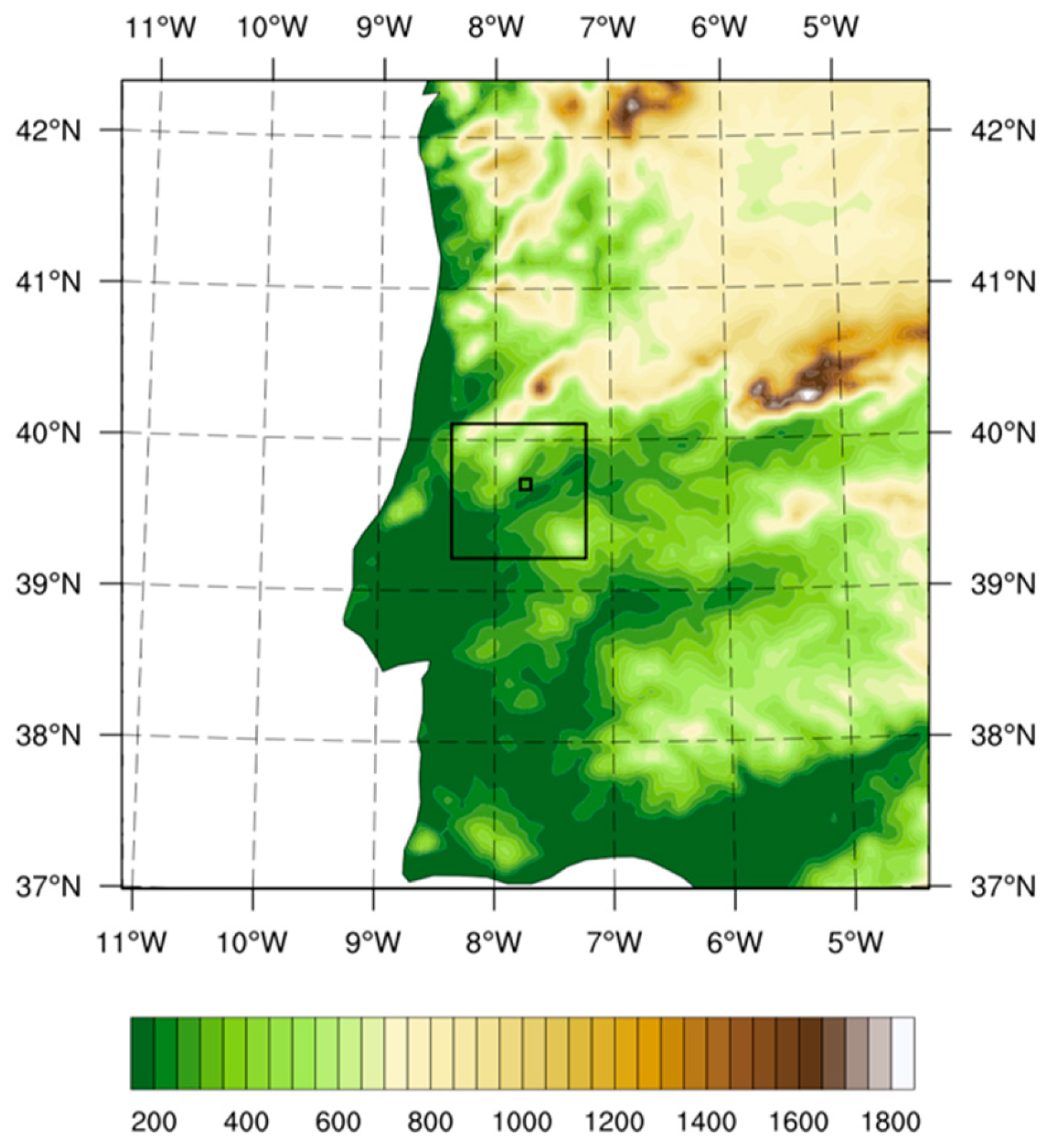
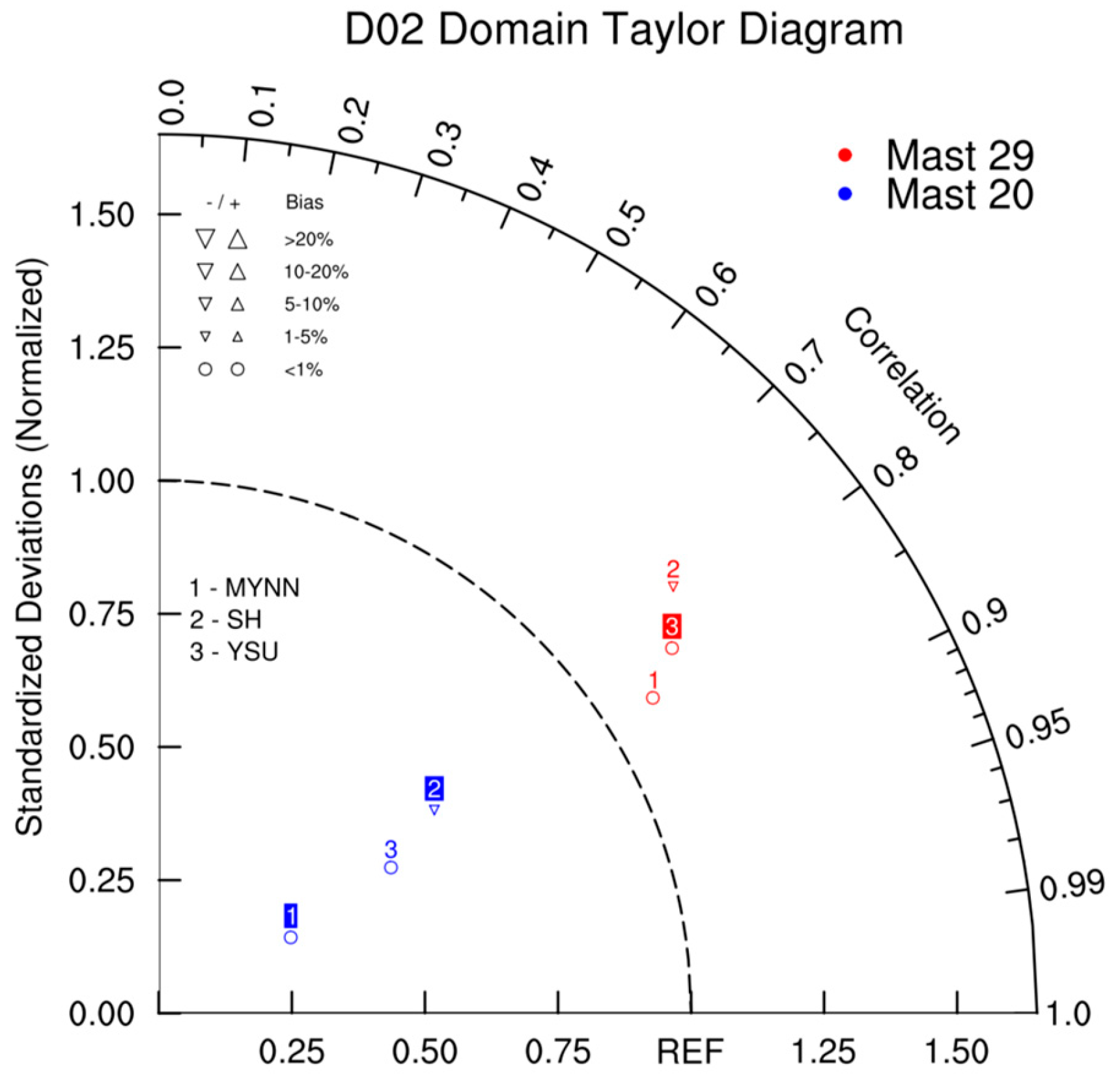

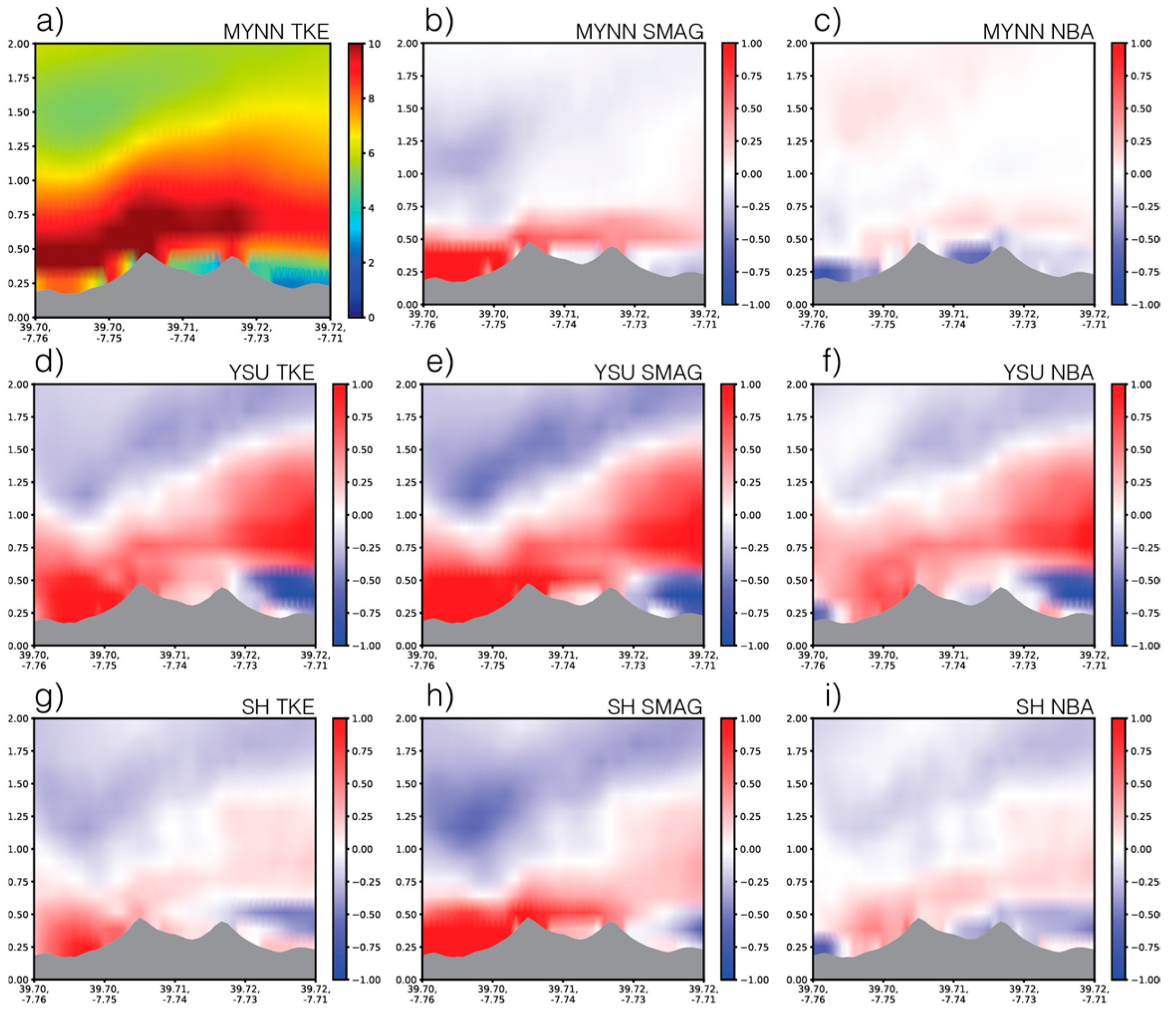



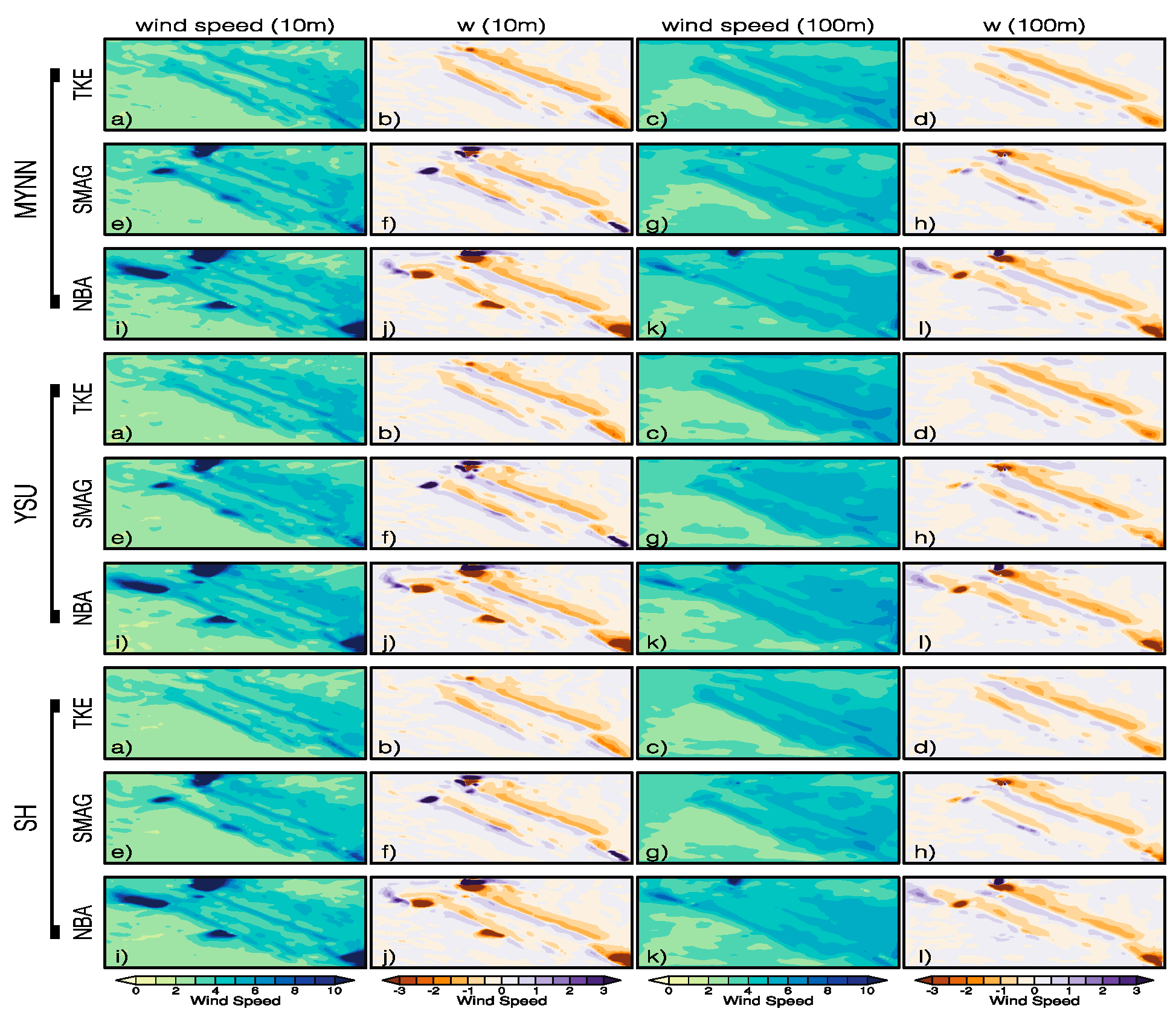
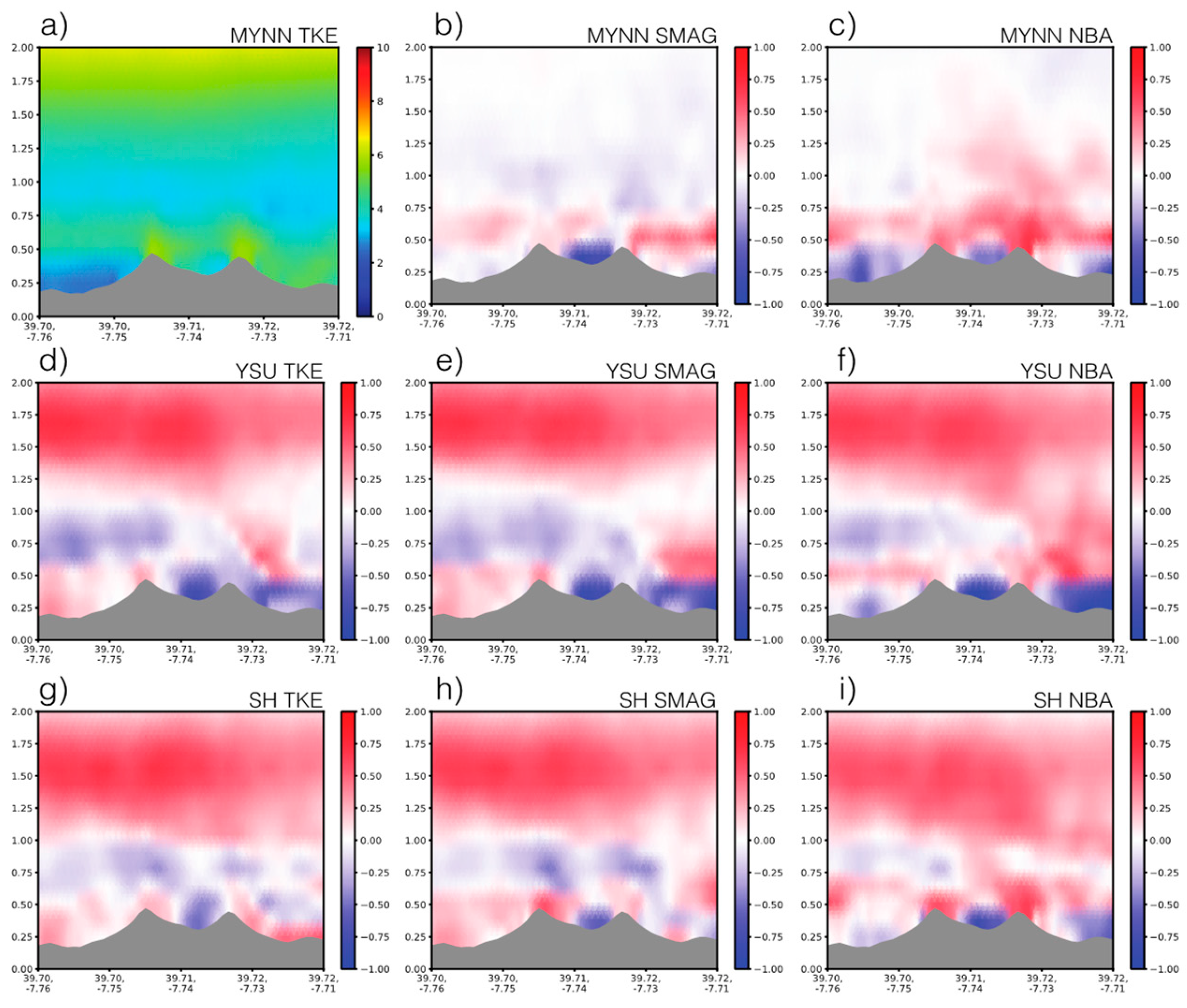
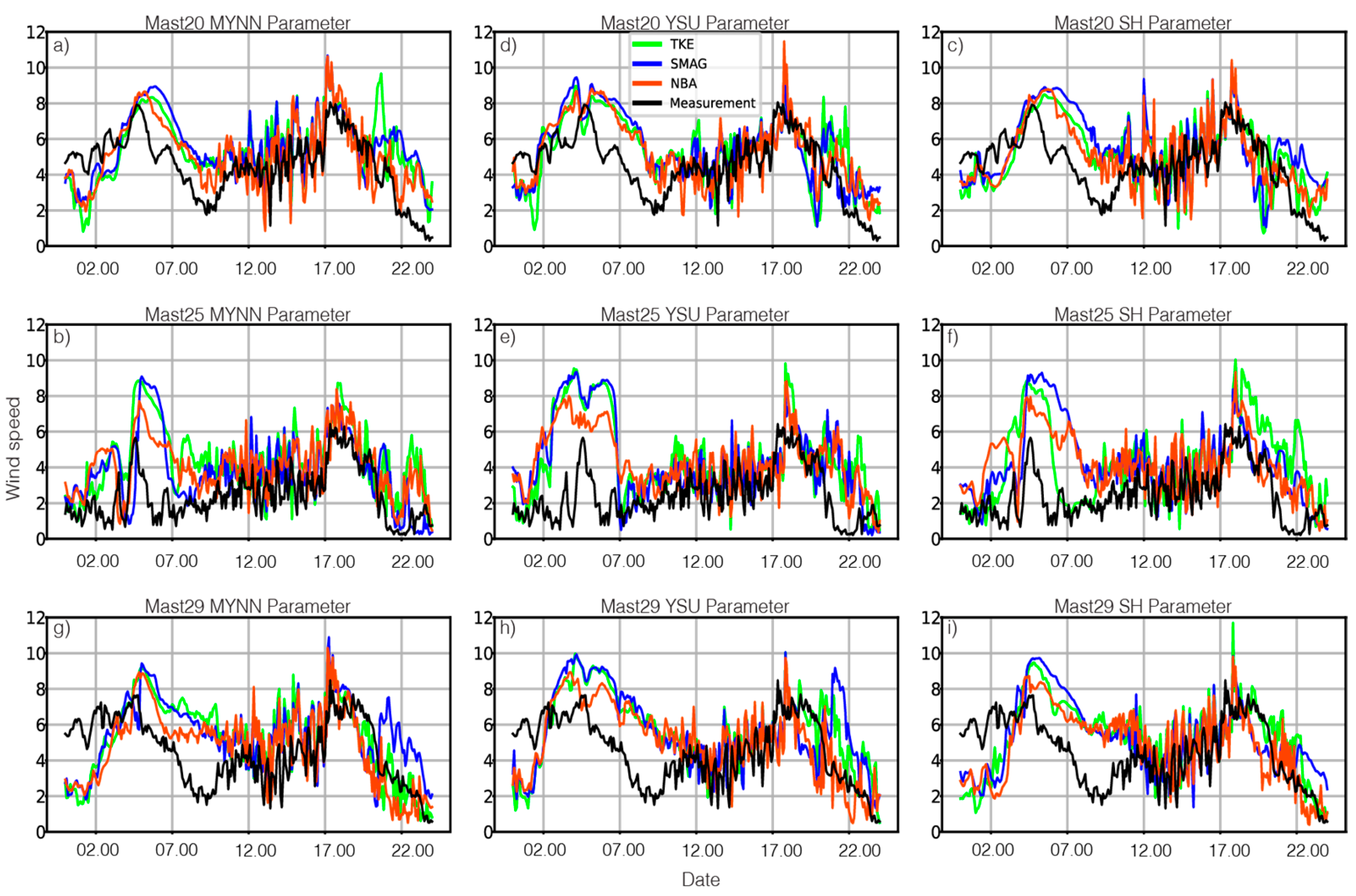
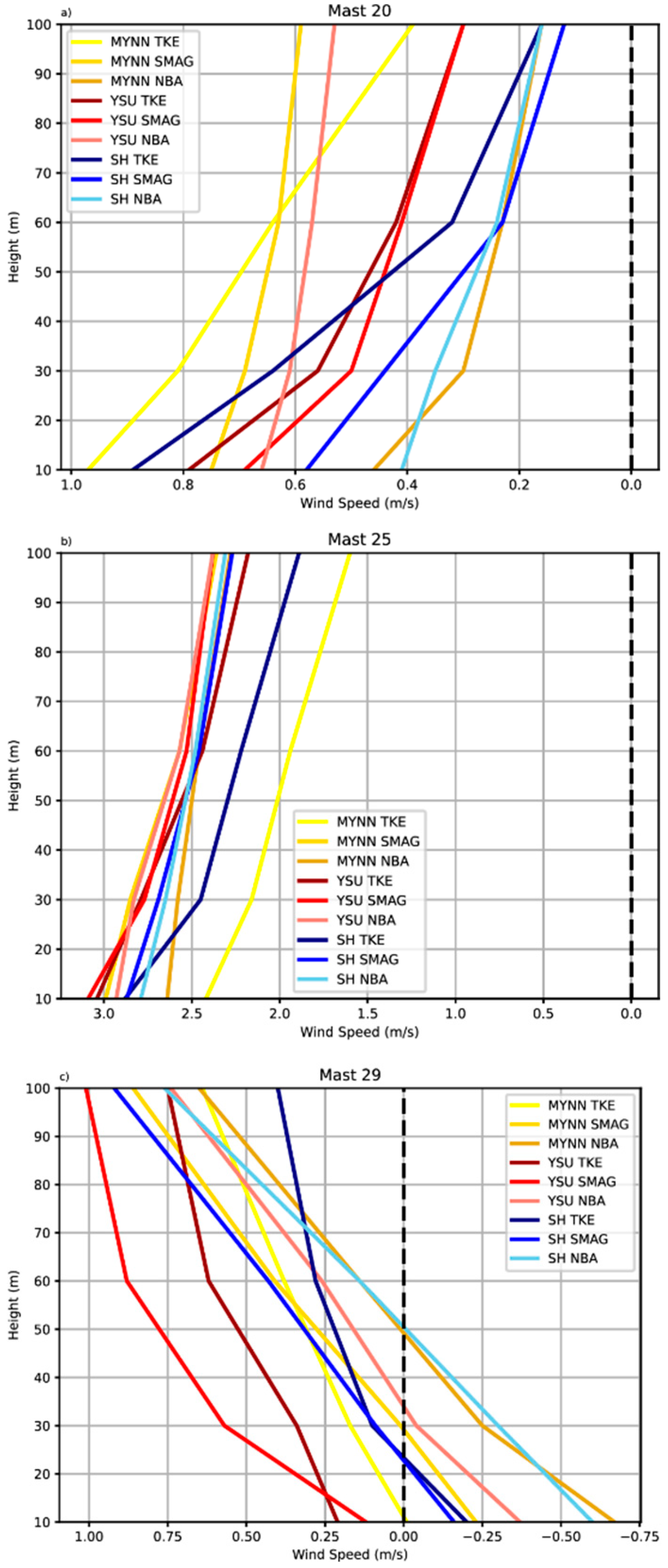
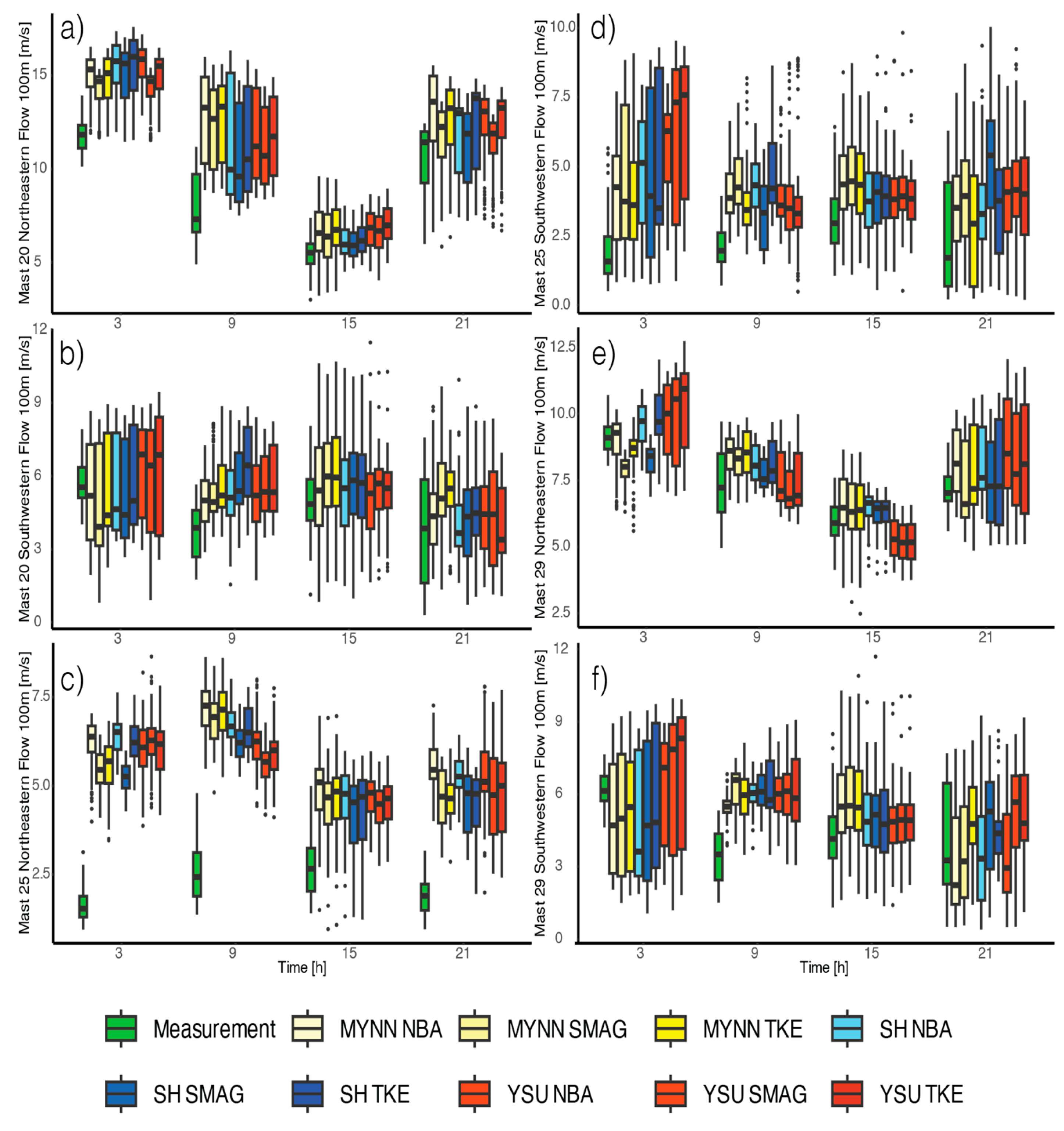
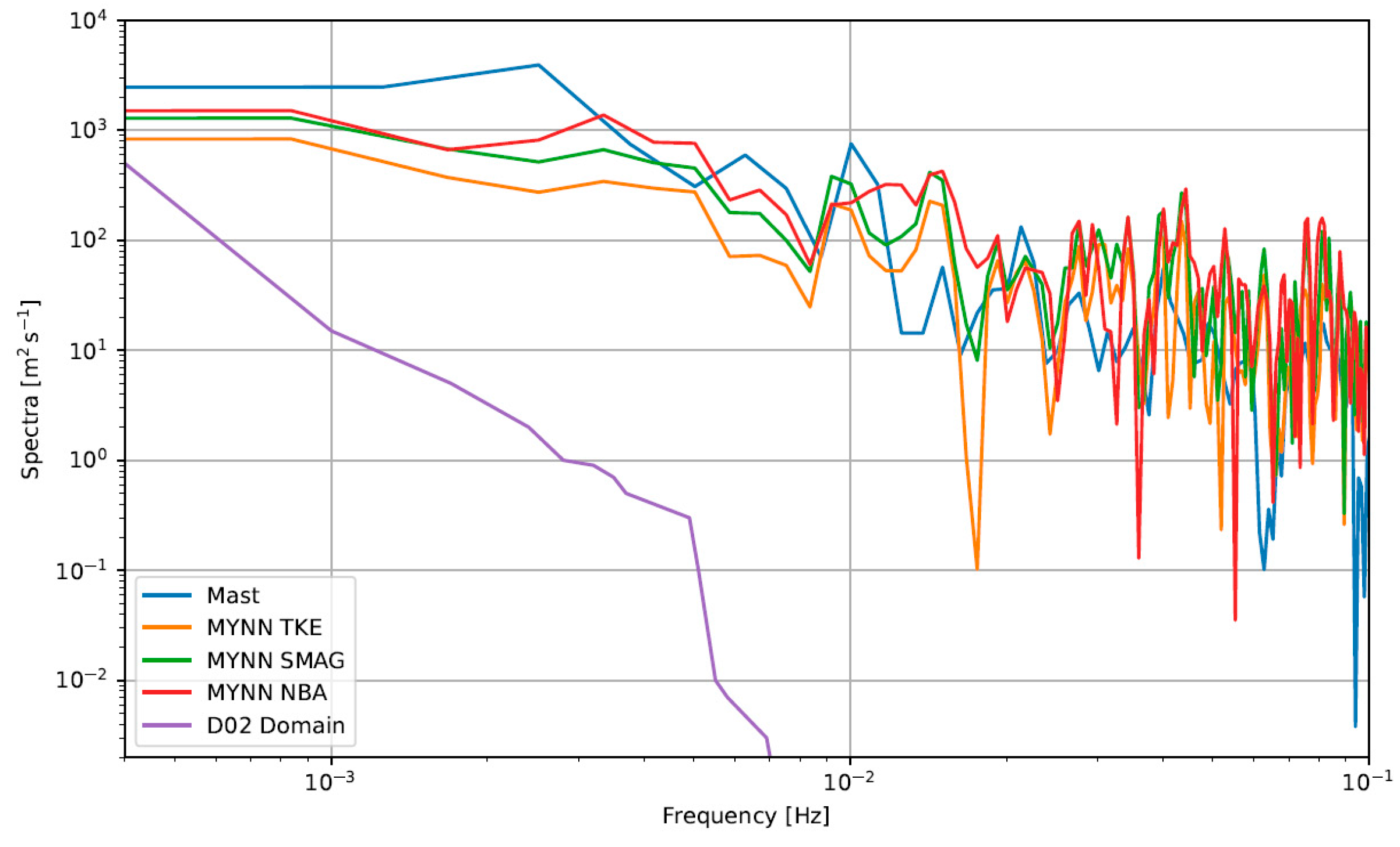
| Domain | Delta X [m] | Nest Ratio | Delta Z [m] | Nx × Ny | Delta t [s] |
|---|---|---|---|---|---|
| d01 | 5000 | - | 50 | 121 × 121 | 5 |
| d02 | 1000 | 5 | 50 | 101 × 101 | 1 |
| d03 | 100 | 10 | 10 | 81 × 81 | 0.2 |
| Name | Mesoscale (d01) 5 km | Mesoscale (d02) 1 km | Microscale (d03) 100 m |
|---|---|---|---|
| MYNN–TKE | MYNN | MYNN | LES (1.5 TKE) |
| MYNN–SMAG | MYNN | MYNN | LES (SMAG) |
| MYNN–NBA | MYNN | MYNN | LES (NBA) |
| SH–TKE | SH | SH | LES (1.5 TKE) |
| SH–SMAG | SH | SH | LES (SMAG) |
| SH–NBA | SH | SH | LES (NBA) |
| YSU–TKE | YSU | YSU | LES (1.5 TKE) |
| YSU–SMAG | YSU | YSU | LES (SMAG) |
| YSU–NBA | YSU | YSU | LES (NBA) |
| Domain | Mast 20 | Mast 25 | ||
|---|---|---|---|---|
| RMSE | Bias | RMSE | Bias | |
| WRF d03 (Δx = 100 m) WRF d02 (Δx = 1000 m) | 1.94 | 0.46 | 3.07 | 2.64 |
| 1.96 | 0.52 | 5.47 | 4.95 | |
Disclaimer/Publisher’s Note: The statements, opinions and data contained in all publications are solely those of the individual author(s) and contributor(s) and not of MDPI and/or the editor(s). MDPI and/or the editor(s) disclaim responsibility for any injury to people or property resulting from any ideas, methods, instructions or products referred to in the content. |
© 2025 by the authors. Licensee MDPI, Basel, Switzerland. This article is an open access article distributed under the terms and conditions of the Creative Commons Attribution (CC BY) license (https://creativecommons.org/licenses/by/4.0/).
Share and Cite
Yılmaz, E.; Menteş, Ş.S.; Kirkil, G. Evaluation of the Sensitivity of PBL and SGS Treatments in Different Flow Fields Using the WRF-LES at Perdigão. Energies 2025, 18, 1372. https://doi.org/10.3390/en18061372
Yılmaz E, Menteş ŞS, Kirkil G. Evaluation of the Sensitivity of PBL and SGS Treatments in Different Flow Fields Using the WRF-LES at Perdigão. Energies. 2025; 18(6):1372. https://doi.org/10.3390/en18061372
Chicago/Turabian StyleYılmaz, Erkan, Şükran Sibel Menteş, and Gokhan Kirkil. 2025. "Evaluation of the Sensitivity of PBL and SGS Treatments in Different Flow Fields Using the WRF-LES at Perdigão" Energies 18, no. 6: 1372. https://doi.org/10.3390/en18061372
APA StyleYılmaz, E., Menteş, Ş. S., & Kirkil, G. (2025). Evaluation of the Sensitivity of PBL and SGS Treatments in Different Flow Fields Using the WRF-LES at Perdigão. Energies, 18(6), 1372. https://doi.org/10.3390/en18061372






